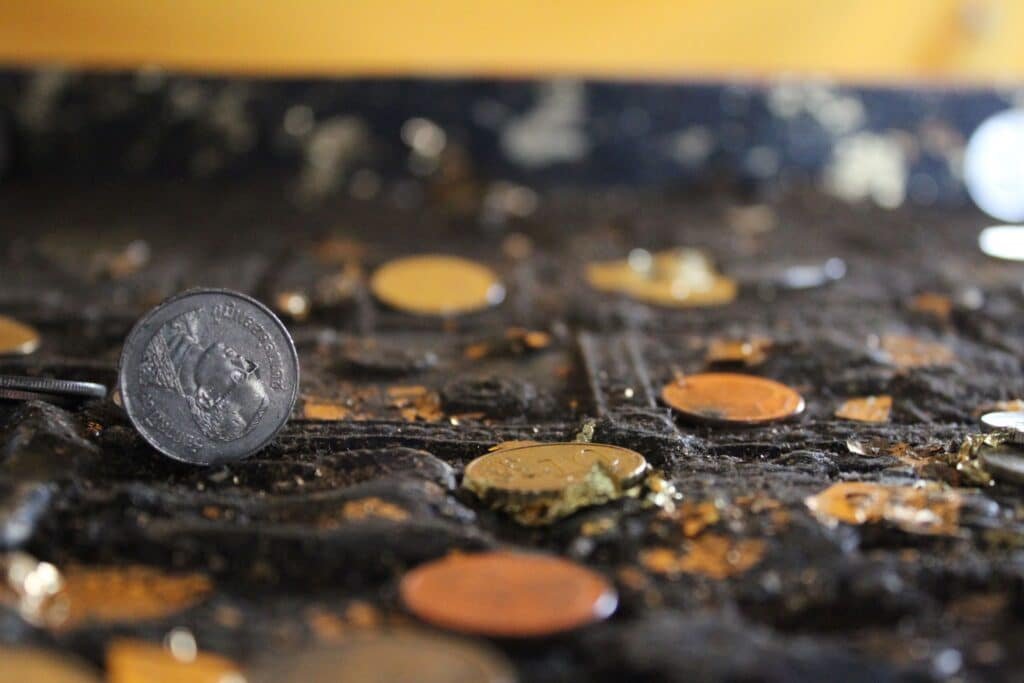From the moment we strap on our backpacks, tell the cats we love them and to behave themselves, and head out to the airport, an invisible target appears on our backs. We are now tourists and therefore the target of every tourist scam in the world. We are strangers in a foreign land, unfamiliar with local customs, and easy prey to every unscrupulous taxi driver and vendor, limber-fingered pickpocket, or full-blown scam artist in our host country. After many hours of research and many years of traveling, we can now successfully avoid the vast majority of these defrauding attempts. The vast majority but nowhere close to all, a feat made proportionally less possible by the more traveling one does.
The very first time I was scammed, I was barely twenty when my best friend and I decided to go to New York, our very first trip anywhere without our parents. Like every twenty-year-old in history, I thought I knew everything while actually knowing next to nothing. At the doors of the sketchy Greyhound bus station, a woman approached me and said that she was $5 short for a bus ticket and asked if I had a few dollars to spare. Of course, I had a few dollars to spare to help a fellow traveler in need! Except I didn’t actually have any small bills and only a $20 bill that I brought along for snacks and taxi fare. I held the $20 in my hand, unsure of what to do next.
“Oh, that’s fine!” The woman exclaimed as if she were doing me a favor, “Let me get you change! I’ll be right back!”
She never came back.
I ate the apples my friend’s mother packed for us for the entire 17-hour journey to New York and tried to forget all about that $20 bill. I had successfully put it out of my mind until a year later when I was at another bus station at college and was approached by a couple asking for just a few dollars for a bus fare home to St. Louis. They ran out of money and were stuck here and really wanted to just go home. They had no luggage on them.
“NO!” I yelled loud enough to startle everyone at the bus stop. “You are not going to St. Louis!”
In retrospect, spectators of my random outburst probably thought I was just a very mean person who wanted to prevent this poor couple from getting home. But I had learned my $20 lesson. And as years passed, I kept on learning.
In Thailand, we quickly figured out that the parked taxis with young drivers leaning on their hoods will cost three times as much as the meter rate. They refused to negotiate the unreasonably large price and snickered at any requests to use the meter. They didn’t need to work all day for peanuts, they could just wait until one tourist who didn’t know any better agreed to the price, and their workday was done. The trick was to find a busy street and flag down a passing taxi. The older the taxi driver, the more chances that he would curtly nod to “Meter, please?” and we would be driven to our destination for pennies. But knowing the scam is half the battle. Several times we were in the position of not having the time to search for another taxi as we were already late to the bus station or airport and knowingly overpaid.

Another common scam we run into all around the world is the “pay for the free item I insist on gifting you” scam. There are multiple variations. In London, we had a woman pretend that she found a gold ring on the ground and try to hand it to me, asking if I lost it. If we had engaged with her and told her it was not our ring, she would have insisted that we take it as a gift and then asked for a small payment for finding us such a valuable item. The ring is, of course, worthless, just plastic with gold paint. In Egypt, a young girl tried to hand me a flower, very insistingly. If I had taken it, the flower she picked off the side of the road would suddenly come with a price tag. In Spain, Romani women offer a spring of rosemary in front of churches to unsuspecting tourists and then will either demand payment for the plant or try to grab your hand for palm reading, an invaluable service that apparently requires payment. I’ve seen this scam with free bracelets from fake monks, with various jewelry, plants, and flowers, with tiny trinkets, and even with “please sign on my clipboard to support some charitable cause… oh, your signature means you have to donate to this cause…” This is the easiest scam to avoid. Don’t engage, smile, and keep on moving.
But some grifts are far more complicated. Before our trip to China, I read about the popular “tea house” scam. The most impressive thing about this scam is that most people didn’t even realize that they have been swindled. It starts simply enough: a pair of two cute Chinese girls approach you at a popular tourist attraction and ask you to take a picture of them. They chat you up and you learn that they are simple country girls, excited to visit a large Chinese city and even more excited to meet foreign tourists. Their English is impeccable, their smiles are infectious, and they are wonderful conversationalists. (This is your first red flag. Chinese, especially from rural areas, are usually wary of strangers, careful with their smiles, and unlikely to speak any English.) After all the usual topics of conversation (Where are you from? What do you do? Where else in China have you been?), they mention that they are heading to a Chinese Tea Ceremony. Would you like to come along? Of course, you would! Who would miss out on a chance to see a genuine Chinese Tea Ceremony with locals no less! (This is your second mistake. There is no such thing as a Chinese Tea Ceremony.) You follow them along narrow alleyways, taking multiple turns until you lose all sense of direction. Finally, you enter a small non-descript building and are greeted by a hostess in a traditional Chinese Hanfu dress. You are seated on pillows on a floor, as the hostess brews tea in front of you with exaggerated gestures, pours tea over a small brass statue of a frog, explaining the significance of this act as bringing luck or happiness or money or whatever she decides to say on this particular day. (Your mistake here is not asking for a menu or the price. You don’t really know what’s going on and just follow the lead of your young companions.) You sample several teas, and your new friends are thoroughly impressed with every cup. So impressed in fact, that they decide to buy several bags of tea to take home. They encourage you to buy some as well. Whether or not you decide to buy any, when the bill comes, the girls explain that in Chinese culture it is appropriate to split the bill evenly. And the bill is enormous. The tea ceremony is at least $50 per person, the 10oz bags of tea start at $100. The girls open their wallets and unflinchingly pay 1/3 of the bill each. You are confused but don’t want to cause a scene or appear to be stingy, so you pay up and smile. (What you don’t know is that the girls are not spending any of their own money. They are employed by this “tea house” and will get all their money back and a percentage of what they convinced you to spend.) At this point, if you still don’t realize you’ve been scammed, the girls will invite you to a circus show happening the next day and will happily sell you tickets for an inflated price of over $100 each. If you are still on board after that, you will be invited to a restaurant after the show, and it will be the most expensive meal you ever had. A lot of tourists, who are only in China briefly, don’t know how badly they have been overcharged and never even realize they’ve been scammed.

Having been prepped about this scam ahead of time, I simply ignored a pretty Chinese girl tugging on my sleeve on the very touristy Wangfujing street, trying to hand me her phone to take a picture of her and her friend. I walked away but kept an eye on her. In a giant crowd of mostly Chinese people, they kept approaching only white tourists with requests to take a picture. Another scam easy enough to avoid - do nothing and walk away.
Other scams are not quite so easy to spot and require you to stay vigilant, especially when handing over your money. In Egypt, it was very common to receive the wrong amount of change back in markets, taxis, and even tourist attractions. In too many countries to name, vendors act as if they don’t have the change to get you to walk away or to buy more. In Albania, tonic water was labeled at 80 cents. I took two and handed over an equivalent of $2. The vendor took it and gave me no change at all. When I pointed at the price, he simply said, “That’s only for one.” So apparently one can is 80 cents and two are $2. Makes sense.
Despite our extensive travel experience, just a few short years ago, we made a laughable rookie mistake in Vietnam. We didn’t ask for the price before using the service. We were at the market, hungry and thirsty, and the mangos looked so juicy and tasty, that I simply pointed at one. Immediately, the vendor peeled it, cut it up into neat slices, and handed it over. The price she named made me almost choke on my first piece of mango. And of course, by that point, she could have named any price in the world and we would have to pay it, after all, the mango couldn’t possibly be returned in its current condition of being actively chewed. It wouldn’t have been so bad, if we didn’t make the same exact mistake in Brazil, years earlier. We were exhausted from the long walk in quickly rising temperatures, with the sun blazing down at us, and were thrilled to have finally reached the beach. The umbrella and chairs vendor ran out to greet us like old friends. Instead of confirming the price, we just asked for two chairs and an umbrella. At the end of the day, when it was time to pay, we were shocked to be casually presented with a bill that could have rented a dozen chairs and umbrellas. Oh well, you live, you learn. Or, in our case, you live and keep making the same mistakes.
More scams and mysteries in the next post!



This is a great post! Thank you so much for sharing your experiences and knowledge of these scams. I had heard some of them, but not all. Thanks for making us aware so we try to avoid these scams. I know sometimes it is really easier said than done and even knowing we all fall prey to the scammers.